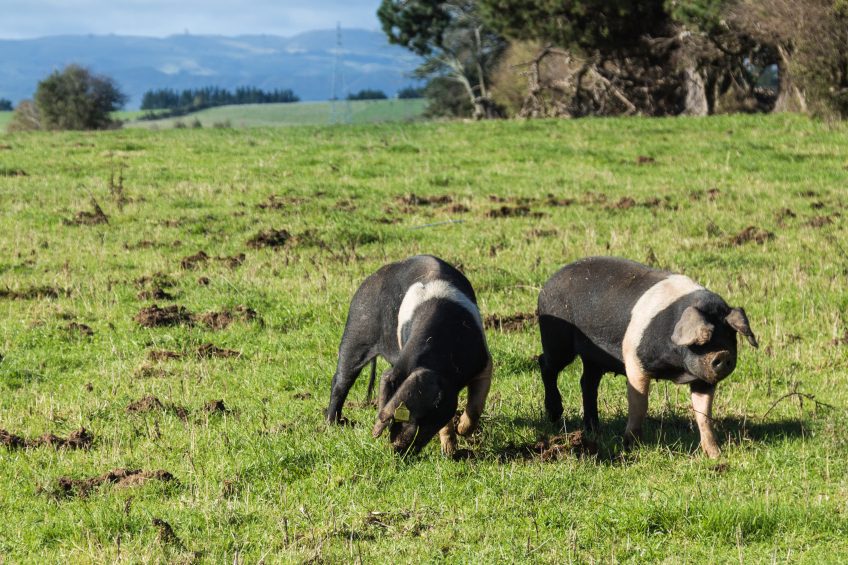New Zealand’s pig industry: Surviving through isolation

Being located remotely, is that a curse or a blessing? For swine producers, it must be a bit of both. On one hand, the isolation provides protection, through the natural barriers, to disease and higher costs of transporting competitor fresh products to the market. On the other, exporting possibilities are difficult.
New Zealand is situated in the Pacific Ocean around 1,600 km from the southwestern corner of Australia. From northern New Zealand the nearest Pacific islands are roughly the same distance.
Whichever way you look at it this is an isolated territory and it is not a country where climate and farming practices foster a significant pig industry. Nevertheless, it is worth reading about how New Zealand’s industry is made up and how it has reacted and changed as its economic circumstances have evolved – and to see how it has survived.

Read more about pig countries all over the world in our Country Focus Tool.
Structure of New Zealand’s pig industry
An overview of the New Zealand pig industry indicates that:
- There are around 100 commercial pig farms in the sector
- The size of the commercial sow herd is estimated to be about 28,800 animals and these are divided roughly 50:50 between outdoor and indoor breeding units
- Sow productivity has increased over the last few years, with the average numbers born alive increasing from 11.9 in 2009 to 13.10 in 2017
- The most recent estimate of annual pig kill (YTD September 2017) was 662,000 animals and an average carcass weight (head on feet on) of 71.04kg
- The average carcass weight of prime market pigs was 69.44kg
Indoor sows v outdoor sows
According to a recent benchmarking survey the output from indoor sows is 26.2 weaners/sow/year and 23 for outdoor herds. New Zealand’s indoor sows have been group housed since December 2015. Around 13,000 sows are farmed outdoors and this reflects the emphasis on and interest in animal welfare policy.
50 new animal welfare rules in development
In 2015 the New Zealand Parliament unanimously passed an amendment to the Animal Welfare Act 1999, in order to specifically recognise animals as sentient beings. The Ministry for Primary Industries is currently developing almost 50 new animal welfare regulations in 2017 (not all aimed at pigs).
Imported pork don’t have to meet NZ’s welfare standards
The New Zealand producers’ organisation, NZPork, is acutely aware that lower priced pork imports do not have to meet the same welfare standards as domestic producers and that this is a strategic threat to local producers. In 2010, NZPork implemented a welfare audit of the entire industry called ‘PigCare’, which is a requirement to allow locally-produced pork to be labelled as, ‘100% NZ Pork, Ham or Bacon’. That 2010 Pigs Welfare Code required that after December 2015 pregnant animals must not be confined in stalls during gestation. The use of mating stalls for service is allowed but for no more than one week.
NZ supports open and free trade
An important aspect of doing business in New Zealand is its government’s attitude to trade policy. On its government website that policy is described thus, “As a trade dependent economy, geographically distant from export markets, New Zealand is a firm supporter of free and open trade. We have one of the most open market economies in the world.”
Figure 1 – New Zealand pigmeat imports and domestic kill, CWE, 2001-July 2017.

These are not empty words and throughout the 1980s and 1990s New Zealand’s farm and trade policies were liberalised. This did not affect the pig industry directly, as it was not heavily subsidised in comparison with other sectors. That said, the New Zealand import trade for pigmeat has grown steadily and now represents almost 60% of pigmeat consumed.
Increase in raw pork imports brings higher health risks
NZPork has made its voice heard about the growth of imports but its objections have been confined to concerns about biosecurity. Local producers believe that they have an advantage over the world because of New Zealand’s unique health status. NZPork claims that the increase in raw pork product imported to New Zealand increases the risk of exposure to animal diseases.
Consumption figures
Per capita consumption of pork is around 24kg and this has grown through time as imports have increased and domestic production has been relatively stable. Most of these imports are frozen pork and therein is a clue to the survival of the domestic industry. New Zealand’s geographical isolation is, effectively, a significant barrier for the import of equivalent fresh/chilled product. That geography provides a line of protection for New Zealand’s pig farmers that a free trade agreement (FTA) or any form of trade liberalisation cannot remove.
Reasons for agribusiness investment and commercial interest in the pig meat value chain are constrained by the size of the domestic and potential export markets. And neither offer significant scale. Two thirds of domestic pigs are slaughtered on the South Island and the other third in the North. There are two major pig breeding companies operating in New Zealand, namely PIC NZ and Waratah Farms. Both companies import genetic material from overseas (USA or Norway).

New Zealand at a glance
New Zealand has a population of 4.5 million people and consists of two main islands and some smaller islands. The country has a temperate climate in the south island and a subtropical climate in the north island. About 43% of the country’s 269,000 km2 is used for agriculture, which employs roughly 32% of the country’s population. Pigs were not known in New Zealand until the European settlers brought them with them. Internationally, the country is particularly well-known for its sheep and dairy business. Nevertheless, New Zealand does have an ‘own’ breed of pig, known as Kunekune, a small breed that descends from traders from Asia. It is often kept as a pet; in Maori language, ‘kunekune’ means ‘fat and round’.
Unfavourable location or survival mechanism?
To sum it all up, New Zealand’s pig farmers and pork consumers are not favoured by their isolation and location in the world. Pigmeat products are, apparently, produced under animal welfare rules that are similar or equivalent to the best in Europe and welfare is identified as being a possible USP for local producers.
Challenges for imports of fresh, chilled products
Pigmeat imports by New Zealand are on an upward trend and per capita consumption is similarly growing. New Zealand’s pig farmers are threatened with extinction by new, foreign sources of competition. The country’s location does, however, offer some hope to the beleaguered domestic industry, as it doesn’t make it easy for overseas suppliers of fresh, chilled product. Logistics will deter imports of fresh pork as does the small population, which probably could not sustain demand for high volumes of imported fresh/chilled cuts.
Price comparisons between meet species
Finally, it’s also worth noting that New Zealand’s large cattle herds and sheep flocks mean that the competitive position between pork, lamb and beef will always be keen. Price comparisons between meat species will be a constant factor and could often be unfavourable to pork – especially high-cost imported fresh pork. Ironically, New Zealand’s pig farmers have allies in their beef and sheep farming brethren.
Special thanks to Ian Barugh, Massey University, New Zealand, for helping to obtain data.











